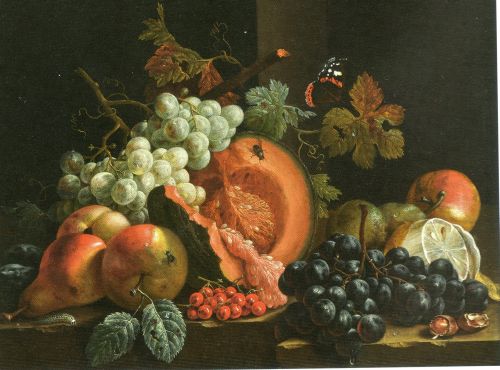Eighteenth century Norfolk pudding
Parson Woodforde, along with many other English people of the middling sort, ate lots of Norfolk puddings during the long eighteenth century and we could do worse than follow suit. These are baked batter puddings that are forgiving to the point of foolproof and would make a welcome surprise for the twenty-first century diner. Once again we have taken Jane Grigson’s recipe from Food with the Famous for a springboard. Six servings.
 3 eggs, separated
3 eggs, separated- 4 Tablespoons flour
- 10 oz milk
- 1 Tablespoon beef dripping (highly recommended) or neutral oil
- 2 lb crisp apples ( see the Notes), peeled, cored and thickly sliced
- 2 oz Demerara or Turbinado sugar
- 2 oz dried fruit (apricots, cranberries, currants, prunes, raisins and the like, alone or in any combination)
- a dusting of confectioners’ sugar
- Whisk the yolks and flour with a little of the milk until the mixture becomes smooth, then gradually whisk the rest of the milk into the batter. ( see the Notes) This is the first step in the recipe because the batter should stand for a while so that it can, as Fergus Henderson might say, become itself.
Preheat the oven to 400°.
- Smear a shallow pie dish just big enough to hold the apple slices with the dripping or oil, array the apple slices on the fat--let them overlap a little--and sprinkle them with the sugar. Bake the apples until they have just colored, usually in about 10 minutes.
- Take the dish out of the oven and increase the temperature to 450°.
- Scatter the dried fruit over the apples.
- Beat the egg whites until foamy and gently fold them into your standing batter, then pour it evenly over the fruit.
- Bake the pudding until it rises and browns, usually in about half an hour.
- Give it a dusting of confectioners’ sugar and serve.
Notes:
- In Britain, our apple of choice for Norfolk puddings would be Cox’s Orange Pippin; in the United States it is Honeycrisp, a hybrid cloned in part from the pip, but MacIntosh or any other “firm eater,” as Mrs. Grigson says, would work.
-If you have a food processor, or even just a blender, at Step 1 you could drop the yolks and milk into the bowl or column and blast them together before dumping the flour into the mix and repeating the process until the batter is smooth.
-A combination of dried apricots and cranberries is particularly appreciated in the household of the Editor.
-It no longer would be a Norfolk pudding, but there is no reason not to use peaches, pears or pineapple, or even soft fruits that do not begin with ‘p’ rather than apples if you like.

